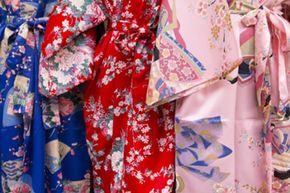Traditional Japanese Clothing
If you went to Japan expecting to see everyone strolling the streets in kimonos, you'd be highly disappointed. As in most industrialized countries, everyday wear is Western-style, or yofuku. Suits for business professionals, jeans and t-shirts for casual wear, and uniforms for students and certain professions, are all the norm. The kimono is still much loved in Japan, however. This national garment evolved from one worn by the Chinese, and originally it was worn open with divided trousers or a split skirt on top.
At its most basic, a kimono is an ankle-length, T-shaped robe with long, wide sleeves and an attached collar. To wear a kimono, you cross the left side over the right and tie it with a sash called an obi. Traditional footwear include geta and zori, both of which resemble flip-flops. Geta have elevated wooden bases with "teeth" on the bottom, while zori are flat, less formal and can be made of a variety of materials. They are often worn with ankle-high, split-toe socks called tabi.
Advertisement
Of course, kimono-wearing is anything but basic, and that's partly why they've mostly been relegated to special occasions and ceremonies. In addition to the kimono, obi and special footwear, there are also numerous related garments, such as the shorter jackets known as haori and under-kimonos, or hiyoku. A formal kimono of the highest quality, with accompanying accessories, can cost tens of thousands of dollars. In the past, kimonos were hand-sewn from a single bolt of hand-dyed silk, and they were often hand-painted as well. Cleaning one meant taking it apart and restitching the garment. Today silk kimonos are often dry-cleaned and worn with a nagajuban -- a plain robe -- underneath to prevent the silk from getting dirty.
Although today's formal kimonos aren't typically as elaborate, there is still a dizzying array of rules and differences regarding how they can be worn, when they're worn and by whom. Women don kimonos far more often, and things like the formality of the event, their age, social status, and marital status dictate the type of kimono they will wear. This includes the material, colors, pattern, placement of the pattern, sleeve length and overall kimono length. The longest, most flowing and most heavily-patterned kimonos are donned only by unmarried women while attending weddings or ceremonies that celebrate 20th birthdays (the age of majority in Japan). Geisha have their own kimono culture and associated accessories -- see How Geisha Work for more details. Getting dressed in a formal kimono is an elaborate, multi-stage process, involving as many as a dozen different pieces and sometimes the assistance of a professional.
Men's kimonos are usually very simple and come in dark, muted colors. Both men and women wear less formal kimonos made of printed cotton or polyester during summer festivals; the simplest of these truly are just robes with sashes and bathers put them on when getting out of public baths.
The design and wearing of a kimono both provide a means of artistic expression for the Japanese. In the next section, we'll explore traditional Japanese art, music and literature.



